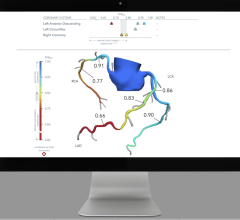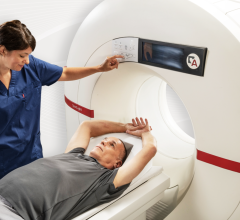March 28, 2014 — At the 63rd Annual Scientific Session of the American College of Cardiology (ACC), March 29-31 at the Walter E. Washington Convention Center in Washington, D.C., Siemens Healthcare will deliver solutions for sustainable cardiovascular care to aid healthcare professionals who, in the race to advance the quality of patient care while keeping pace with modern healthcare’s many challenges, are “in it for the long run” — the theme of this year’s booth. Facilitating improved patient outcomes and enhanced economic efficiency, Siemens offers a comprehensive portfolio of systems and support solutions that range from imaging modalities to information technology (IT) and in vitro diagnostics.
At ACC 2014, Siemens will showcase its new Artis one[1] angiography system, which is designed around the needs of the interventionist and optimized for broad clinical utilization, with features that provide increased patient comfort and access. The Artis one is designed for routine interventions, including percutaneous coronary interventions, revascularizations of peripheral arterial or venous occlusions, functional tests of dialysis shunts in patients with kidney failure, and pacemaker implantations.
With a positioning flexibility similar to ceiling-mounted systems despite being floor-mounted, the Artis one occupies just 269 square feet, compared to the standard 484 square feet required by ceiling-mounted systems. It features several axes that can move independently of one other, enabling physicians and hospital staff to easily position the system regardless of where they stand. It accommodates body heights of up to 6 feet, 10 inches including peripheral vessel imaging without the need for repositioning. When necessary, the Artis one allows free access to the patient's head, enabling optimal care during the procedure.
Siemens also will feature its Artis Q and Q.zen angiography systems families, with X-ray tube and detector technology designed to improve minimally invasive therapy for coronary artery disease, pediatrics, and electrophysiology. Siemens’ new X-ray tube uses flat emitter technology, which enables smaller, square focal spots that lead to as much as 70 percent improved visibility of small vessels and improve image quality. The Artis Q.zen combines this X-ray tube with new crystalline detector technology that allows imaging at patient doses as low as half the standard angiography levels.
Elevating Abdominal Vascular Imaging
The Abdominal Vascular Release (Release 3.5) of the Acuson SC2000 ultrasound system elevates the standards for image quality and ease of use in abdominal vascular imaging. The system is equipped with the 6CI HD high-density curved array probe that combines, for the first time, an HD transducer with Siemens’ exclusive IN Focus technology for exceptional detail and contrast resolution throughout the entire field of view. Additionally, the system has the improved 4V1c Access transducer, which features a significantly smaller contact area and enables easier access through the rib spaces for faster exams on difficult-to-image patients. The Abdominal Vascular Release of the Acuson SC2000 also offers new workflow improvements, time savings and a reduction in keystrokes, helping to improve workflow. The system’s eSie Access measurement interface provides a context-sensitive menu for technologists to access relevant automated measurements with a single button-click.
Also, Siemens will showcase the Acuson X700 ultrasound system, which is designed to quickly process complex information for detailed visualization and assessment of cardiac anatomy and physiology. Fully featured for transthoracic, transesophageal (TEE), and intracardiac echocardiography imaging, the Acuson X700 possesses advanced features migrated from Siemens’ premium ultrasound platforms, including Dynamic TCE tissue contrast enhancement technology, which provides distinct delineation of valve detail and the myocardium. The Acuson X700 has a wide range of transducers, including five optional Micropinless (MP) transducers specific to cardiovascular imaging. The MP transducers are designed to offer higher signal fidelity and improve signal-to-noise ratio, enhancing signal quality. The 4V1c Access transducer is also available on the Acuson X700 system. Additionally, the system includes knowledge-based tools that automate workflow and support customized pre-sets, measurements, and calculations, helping the user deliver precision, performance, and efficiency.
Enabling CT Chest Imaging With No Breath-hold
The next generation in dual source computed tomography (CT), Siemens’ new Somatom Force [2] CT system enables considerably faster imaging and the possibility to achieve dose reductions.
The Somatom Force CT system has an acquisition rate of 737 mm per second while maintaining contrast-to-noise ratio. The Somatom Force also enables free-breathing CT by combining the scanner’s high speed with its excellent temporal resolution.
With its two sources and an outstanding rotation speed of 250 ms, the temporal resolution in cardiac imaging can be increased to 66 ms. Flash Spiral together with extended detector coverage enables the SOMATOM Force to provide a maximum acquisition speed of up to 737 mm/s or scan at full 50 cm field of view (FoV) at close to 40 cm/s. Siemens’ unique Turbo Flash Spiral scan mode brings the benefits of Flash scanning to a broader range of patients than ever before, making it the fastest, most versatile scan model in the industry.
Offering nuclear cardiology solutions
Nuclear cardiologists who use Siemens’ Symbia Intevo 3 xSPECT [3] modality — the next stage of evolution in SPECT and CT integration — can dramatically reduce the length of imaging protocols with IQ-SPECT, a field-upgradeable hardware/software combination that enables the reduction of imaging protocols from 16 minutes to less than five minutes. These shortened exams allow a sustainable approach to nuclear cardiology that enables reduced patient dose and provides high-quality diagnostic information.
Siemens’ Biograph mCT Flow [3] positron emission tomography/CT (PET/CT) system helps assess coronary artery disease (CAD) and heart damage as well as differentiate healthy muscle from damaged muscle. Also featured with cardiac PET at ACC 2014: syngo Myocardial Blood Flow, which provides measurement of myocardial blood flow analysis with single-injection protocols, no additional scan time or dose; and HD-Chest — a single-trigger, dual-gating technique for improved visualization of myocardial tracer distribution, wall thickness and defect definition.
Optimizing Cardiac Workflow with Dot
Siemens developed the Cardiac Dot (Day optimizing throughput) Engine to reduce the complexity of cardiac magnetic resonance imaging (MRI) scanning and to increase productivity by guiding the user through cardiac exams. With a few mouse clicks, the Cardiac Dot Engine automatically selects customized protocols based on the patient’s condition and clinical indication. Through user guidance, patient personalization, and exam automation provided by Cardiac Dot workflow technology, users can increase productivity in the healthcare setting as much as 50 percent.[3]
Providing Quantitative Cardiac Assays
The Stratus CS Analyzer for acute care diagnostics provides quantitative cardiac assays for fast, accurate evaluation of patients presenting with suspected myocardial ischemia (MI) at the point of care. These assays include the Stratus CS Acute Care Troponin 1 method (cTnl), which by helping to improve the diagnostic accuracy and rapid detection of MI, facilitates earlier detection of myocardial injury, enabling more rapid diagnosis and faster initiation of appropriate therapy. The company also offers troponin assays on several of its core testing platforms, including ADVIA Centaur systems, Dimension Vista systems and Dimension EXL systems. For the Stratus CS system, the high-sensitive troponin assay [5] can be used as an aid in the diagnosis of acute myocardial infarction (AMI).
Helping to Streamline Workflow
syngo Dynamics, Siemens’ cardiovascular imaging and information system, helps streamline workflow and optimize clinical utilization with accelerated reading and efficient reporting. In conjunction with syngo.via, [6] users have fast access to advanced visualization for multi-modality reading of cardiovascular images.
Caregivers can team up more efficiently to utilize additional documentation capabilities with collaborative reporting – at any time after the procedure, and by working simultaneously on a report for the same study. The electronic Whiteboard [7] enhances ease of use by organizing and expediting patient flow, allowing healthcare teams to be more efficient, which facilitates the focus on patient care.
References:
1 Artis one is pending 510(k) clearance and is not yet commercially available in the United States and other countries.
2 The SOMATOM Force is pending 510(k) clearance and is not commercially available in the United States.
3 Symbia Intevo, xSPECT, and Biograph mCT Flow are not commercially available in all countries. Due to regulatory reasons, their future availability cannot be guaranteed. Please contact your local Siemens organization for further details.
4 Case study by Dr. Russell Bull, Royal Bournemouth Hospital, U.K.
5 Defined by the ESC/ACC committee as an imprecision level of ?10% at the 99th percentile of normal population.
6 syngo.via can be used as a standalone device or together with a variety of syngo.via-based software options, which are medical devices in their own right. syngo.via and the syngo.via-based software options are not commercially available in all countries. Due to regulatory reasons, future availability cannot be guaranteed. Please contact your local Siemens organization for further information.
7 This feature is only available for sale in the United States and Canada.
For more information: www.healthcare.siemens.com


 July 16, 2024
July 16, 2024 








